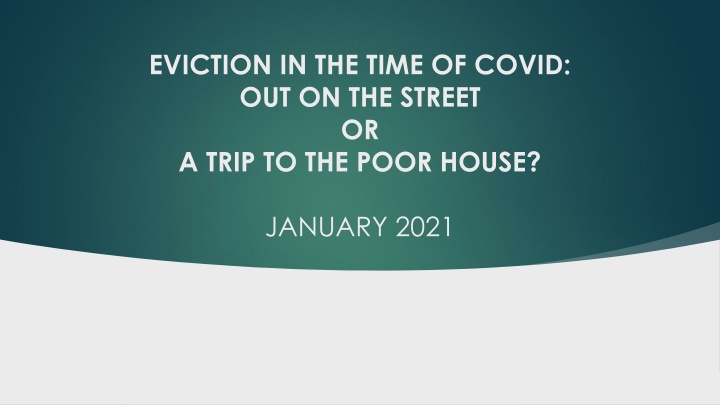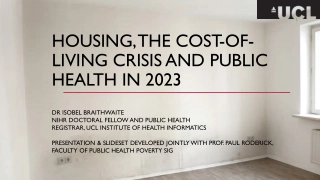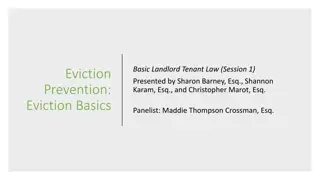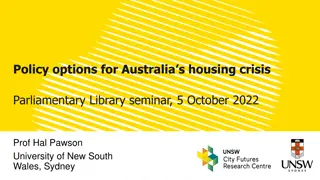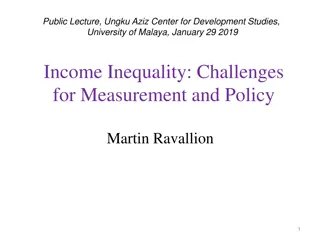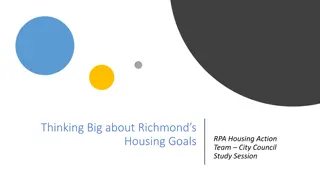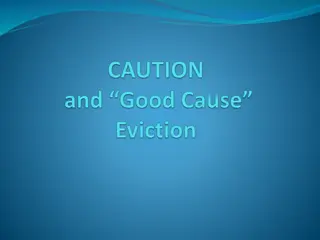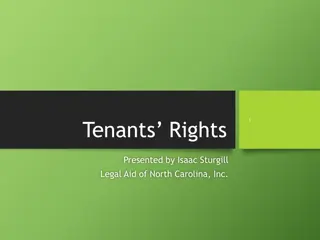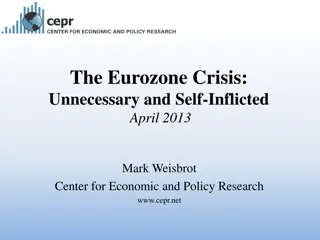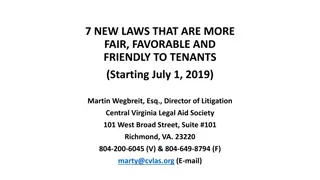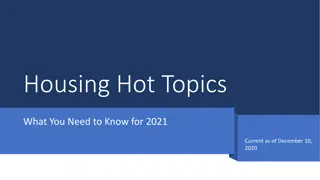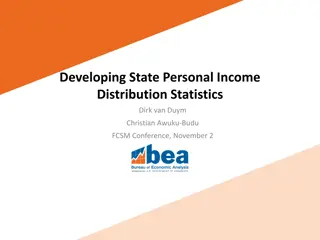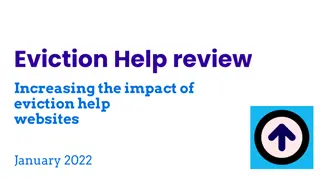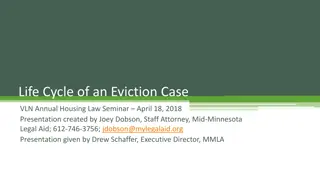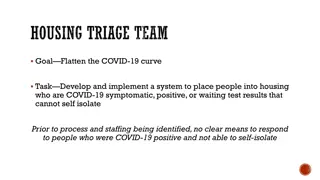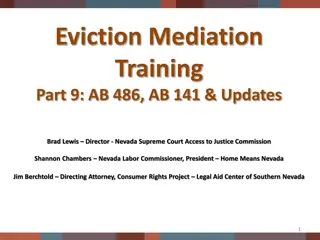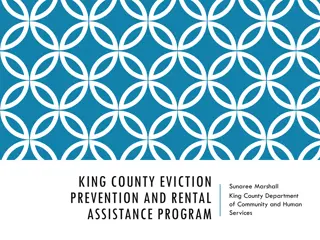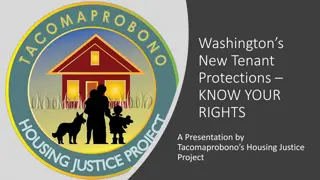Eviction Crisis in Washington State: Impact of COVID-19 and Housing Inequality
The study highlights the concerning trends of evictions in Washington state, showing racial disparities and the burden of rent affordability. It discusses the challenges faced by tenants, including lack of legal representation and high court costs, emphasizing the need for solutions to address the eviction crisis exacerbated by the COVID-19 pandemic.
Download Presentation

Please find below an Image/Link to download the presentation.
The content on the website is provided AS IS for your information and personal use only. It may not be sold, licensed, or shared on other websites without obtaining consent from the author.If you encounter any issues during the download, it is possible that the publisher has removed the file from their server.
You are allowed to download the files provided on this website for personal or commercial use, subject to the condition that they are used lawfully. All files are the property of their respective owners.
The content on the website is provided AS IS for your information and personal use only. It may not be sold, licensed, or shared on other websites without obtaining consent from the author.
E N D
Presentation Transcript
EVICTION IN THE TIME OF COVID: OUT ON THE STREET OR A TRIP TO THE POOR HOUSE? JANUARY 2021
1. 1. Washington Evictions Washington Evictions Big Picture Issues Issues Washington s Eviction Moratorium Intent to Sell Premises Skit Health & Safety Issue Skit Early Resolution Program (ERP) Brief Overview of New Program Available for King, Pierce, Snohomish, Thurston, Clark, and Spokane Counties. Breakout Rooms Big Picture 2. 2. Washington s Eviction Moratorium i. PRESENTATION PRESENTATION OVERVIEW OVERVIEW: : ii. 3. 3. Early Resolution Program (ERP) 4. 4. Breakout Rooms
Several general trends are apparent in Washington evictions: Pervasive Pervasive Between 2013 and 2017, 1 in 55 Washington adults had an eviction (130,203 adults which equals 1.8% of the Washington s adult population) Frequently Frequently Unlitigated Unlitigated on Merits In 2017, 3,238 unlawful detainers were filed in Pierce County and 1,476 resulted in default judgments (roughly 47%) Lack of Legal Representation Lack of Legal Representation From 2004 to 2017, only 8% of unlawful detainer defendants had legal representation at any point in the eviction process. 1. 1. i. CONTEXT FOR CONTEXT FOR WASHINGTON WASHINGTON EVICTIONS: EVICTIONS: on Merits 2. 2. i. 3. 3. i.
4. Racially Disproportionate In Pierce County, 1 in 6 black adults were evicted between 2013 and 2017. In King County, 1 in 11 black adults were evicted in King County over the same time period. For white adults, 1 in 50 in Pierce County and 1 in 100 in King were evicted. CONTEXT FOR CONTEXT FOR WASHINGTON WASHINGTON EVICTIONS: EVICTIONS: 5. Affordable Housing, Evictions, and Homelessness Appear Intertwined 6. Numerous Washingtonians are Rent-Burdened Nearly 500,000 Washingtonians are rent- burdened (paying over 30% of monthly income to rent).
4. Racially Disproportionate In Pierce County, 1 in 6 black adults were evicted between 2013 and 2017. In King County, 1 in 11 black adults were evicted in King County over the same time period. For white adults, 1 in 50 in Pierce County and 1 in 100 in King were evicted. UNLAWFUL DETAINER DEFAULT JUDGMENT RATES 5. Affordable Housing, Evictions, and Homelessness Appear Intertwined 6. Numerous Washingtonians are Rent-Burdened Nearly 500,000 Washingtonians are rent- burdened (paying over 30% of monthly income to rent)
A significant amount of unlawful detainer filings end in default judgment. The consequence of failing to respond to an eviction summons or a no- show at hearing almost surely guarantees that the tenant will face the strictest enforcement and costs of an eviction. UNLAWFUL DETAINER DEFAULT JUDGMENT RATES A 2017 study in Seattle found that the median court costs for over 1,000 eviction cases were $3,129.73, which included rent-owed, non-rent charges, and legal costs. In addition to the mark of an eviction, these costs compound the consequences of evictions. (Losing Home: The Human Cost of Eviction in Seattle, 2017)
TENANT LEGAL REPRESENTATION
Legal representation during unlawful detainer greatly increases tenant outcomes. A single eviction can prevent families from public housing resources and impact credit scores. Evictions make housing searches more difficult and often lead to increased moving costs. TENANT LEGAL A 2017 study found that tenants with legal representation were twice as likely to stay in their homes as compared to self-representation. REPRESENTATION From 2004 to 2017, less than 8% of all Washington tenants had an attorney at their eviction hearing, while over 90% of landlords were represented at hearing.
RACIAL DISPARITY IN WASHINGTON EVICTIONS
From the five-year period from 2013 to 2017, roughly 9% of black adults in King County and 17% of black adults in Pierce County faced an eviction. Latinx adults, a population close in proportion to black adults in King and Pierce counties (compositions of 7.6% in King, and 8.1% in Pierce, respectively), faced much lower eviction rates of 3% in King, and 3.7% in Pierce. White adults were third with roughly 1.5% and 2.6% eviction rates in King and Pierce Counties, while Asian adults composed the lowest rate of 0.5% and 1.7%. RACIAL DISPARITY IN WASHINGTON EVICTIONS Put another way, black adults are 5.5 times more likely than white adults in King County to be evicted, and 6.8 times more likely in Pierce County. Latinx adults are evicted 1.9 times and 1.4 times more than white adults in King and Pierce Counties. Asian adults were evicted almost half as much as white adults. In 2019, the Tacoma-Pierce County HJP represented 268 clients at eviction show cause hearings: 46% black (122 clients); 34% white (92); 5% Hispanic/Latino (14); 3% Native American (9); 3% Pacific Islander (9); 2% Asian (6); and 7% Other (16).
: INTERTWINED TRENDS
: During the recovery from the recession, affordable units slightly increased along with declines in homelessness and evictions. However, by 2012, Washington started to lose affordable housing largely to rising rents and the following year started an increase in homelessness. During this time, evictions kept a steady pace until about 2014 where it started to slump while homelessness took a drastic rise. INTERTWINED TRENDS By 2017, we lose a large portion of affordable housing stock, see homelessness increasing beyond recession numbers, and evictions keeping a steady pace since 2009. While evictions seem down, there are still over 18,000 cases, only a few percentage points down from eight years earlier. Note: Surveys during the point in time count show that each year, over 90% of those counted were from Washington state (contradicting the myth of migrant homelessness).
: PIERCE COUNTY
: WASHINGTON RENT BURDEN
: Almost half of all Washington renters (46%) are rent burdened. These renters are paying more than 30% of their income to rent. 250,000 households are paying between 30% to 50% of their income to rent and another 250,000 are paying over half their income to rent a combined total of 500,000 households. WASHINGTON RENT BURDEN This leaves a large portion of the Washington s renter population near the brink of losing their homes at any time with a disruption of income or unexpected expenses. COVID-19 Situation: [A]s of November 2020, current information suggests 165,000 tenants in Washington will be unable to pay their rent in the near future. Governor Proclamation 20-19.5.
: March 18 March 18 April 17, 2020 April 17, 2020 (no issuing evictions for non-payment or terminations of tenancy; landlords cannot start eviction proceedings for writs of restitution, unless health, safety and welfare issue) April 16 April 16 June 4, 2020 June 4, 2020 (expanded covered persons to include non- traditional tenancies; no issuing notices requiring tenants to vacate unless health, safety, and welfare, no assessment of late fees; no increases in rent; rent is an unenforceable debt unless a repayment plan is offered) WASHINGTON EVICTION MORATORIA June 2 June 2 August 1, 2020 August 1, 2020 (allowing terminations for landlords intent to personally occupy or sell premises) July 24 July 24 October 15, 2020 October 15, 2020 (DSHS transfers and discharges) October 14 October 14 December 31, 2020 December 31, 2020 (requiring affidavit for intent to occupy or sell; allowing customary contact between landlord and tenant; allowing increases in rent once moratoria expire; clarifying conduct creating health and safety risk for terminations) December 31 December 31 March 31, 2021 March 31, 2021 (expressly removing emergency shelters providing supportive services from moratorium protections)
: Covered Situations: residents of traditional dwellings . . . as well as those who have lawfully occupied or resided in less traditional dwelling situations for 14 days or more, whether or not documented in a lease, including . . . roommates who share a home; long-term care facilities; transient housing in hotels and motels; Airbnb's; motor homes; RVs; and camping areas Governor s Proclamation 20-19.5. CURRENT MORATORIUM PROVISIONS
: Landlords or agents are prohibited from serving or threatening to serve any eviction notice requiring a resident vacate a dwelling or parcel of land occupied as a dwelling Exception #1: landlord attaches affidavit attesting that eviction is necessary to respond to a significant and immediate risk to the health, safety, or property of others created by the tenant NOTABLE PROVISIONS Must be described with particularity Cannot be established by resident s own health condition or disability Excludes situations which a resident has been exposed to COVID-19 or is following Department of Health guidelines regarding quarantine or isolation Excludes situations that are not urgent in nature such as conditions known or knowable prior to COVID-19, but which no action was taken.
: Exception #2: Landlord provides 60-day notice with affidavit indicating property owner s intent to personally occupy the premises as the owner s primary residence. Exception #3: Landlord provides 60-day notice with affidavit indicating property owner s intent . . . to sell the property. Landlords or agents are prohibited from seeking or enforcing, or threatening to seek or enforce, judicial eviction orders, unless above-listed exceptions. Law enforcement are prohibited from serving, threatening to serve, or otherwise acting on eviction orders, unless above-listed exceptions. Landlords are prohibited from assessing, or threatening to assess, late fees for non-payment or late payment of rent from February 29, 2020. NOTABLE PROVISIONS
: Landlords or agents are prohibited from treating any unpaid rent or other charges . . . as an enforceable debt or obligation that is owing or collectible when such non-payment was a result of COVID-19 and occurred after February 29, 2020. NOTABLE PROVISIONS This includes attempts to collect, or threats to collect, through a collection agency, by filing an unlawful detainer or other judicial action, withholding any portion of a security deposit, billing or invoicing, reporting to credit bureaus, or by any other means. Exception: This prohibition does not apply to a landlord . . . who demonstrates by a preponderance of the evidence to a court that the resident was offered, and refused or failed to comply with, a re-payment plan that was reasonable based on the individual financial, health, and other circumstances of that resident
: Landlords may engage in customary and routine communications with residents of a dwelling or parcel of land occupied as a dwelling, including, documenting a lease violation without threatening eviction, providing information to residents regarding financial resources, and providing residents with information on how to engage them regarding reasonable repayment plans. NOTABLE PROVISIONS Violators of this order may be subject to criminal penalties pursuant to RCW 43.06.220(5) ( Any person willfully violating any provision of an order issued by the governor under this section is guilty of a gross misdemeanor. )
: SKIT PRESENTATION
: Since February 2020, nearly one million people in Washington state lost their jobs or had employment hours curtailed because of the COVID-19 emergency. Recent information suggests 165,000 Washington tenants will not be able to pay rent in the near future. EVICTION RESOLUTION PILOT PROGRAM (ERP) Roughly 80% of all unlawful detainer filings in Washington are based on non-payment of rent. Washington s eviction moratoria are temporarily prohibiting issuing notices for non-payment of rent or seeking evictions based upon non- payment of rent. Also, for rent to be collectible debt, a reasonable payment plan must be offered to the tenant in arrears. However, state and local rent assistance programs funded by emergency federal, state, local, and philanthropic funds have been established to preserve tenancies threatened due to the non- payment of rent. The ERP is an initiative established by the courts to facilitate early resolution of disputes over non-payment of rent during and after Washington s eviction moratorium. Six pilot counties: King, Pierce, Snohomish, Thurston, Clark, and Spokane.
: Notice 1 Notice 1: Sent to tenant with accompanying notice of non- payment of rent and informs tenant of ability to obtain Dispute Resolution Center and Housing Justice Project assistance. Notice 2 Notice 2: Similar notice form as Notice 1, but sent to tenant, local DRC and HJP. DRC attempts to contact unresponsive tenants for seven days. EVICTION RESOLUTION PILOT PROGRAM (ERP) Local Dispute Resolution Center (DRC) Local Dispute Resolution Center (DRC) receives landlord notices then engage tenants, Housing Justice Project attorneys, and administrators of rental assistance programs. DRC to provide conciliation efforts between tenants and landlords, with HJP and landlord attorneys present. If conciliation successful, no unlawful detainer filed. If unsuccessful, parties provide optional mediation for non- payment issue. After an unsuccessful conciliation or mediation, DRC issues certification form required for landlord to file unlawful detainer action.
: The State of Evictions: Results from the University of Washington Evictions Project: https://evictions.study/washington/index.html#fn10 Governor s Proclamation 20-19.5: https://www.governor.wa.gov/sites/default/files/proclamat ions/proc_20-19.5.pdf Eviction Resolution Program Information: http://www.courts.wa.gov/newsinfo/index.cfm?fa=newsinf o.EvictionResolutionProgram Tacoma-Pierce County Housing Justice Project: https://tacomaprobono.org/hjp/ SOURCES AND FURTHER INFORMATION
